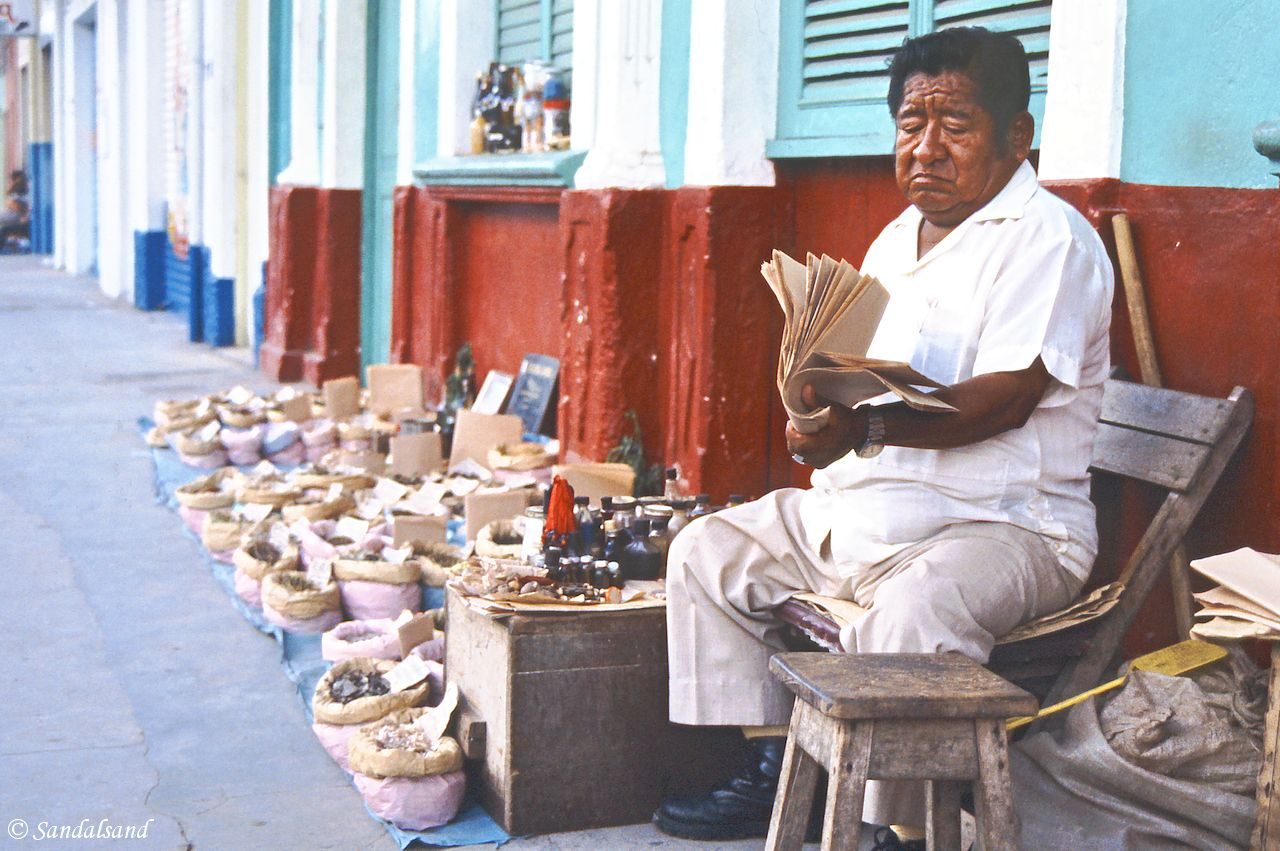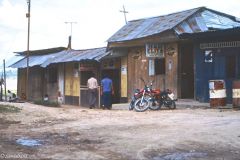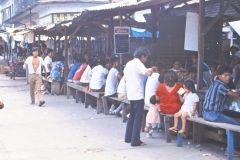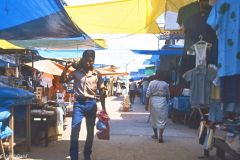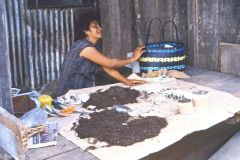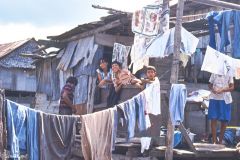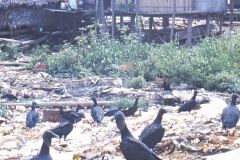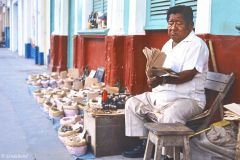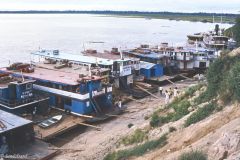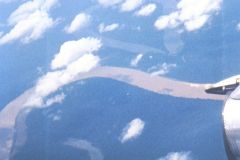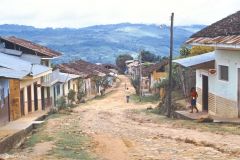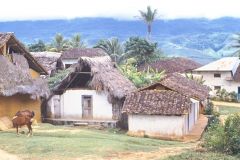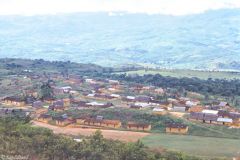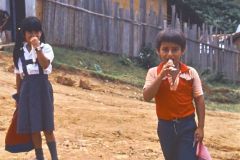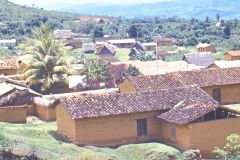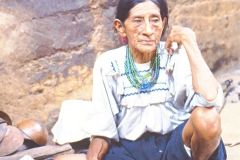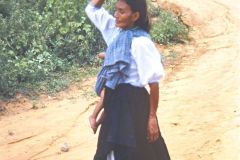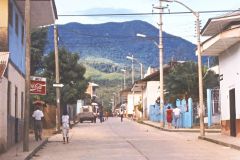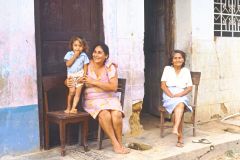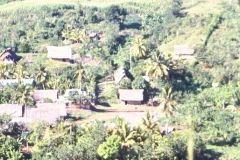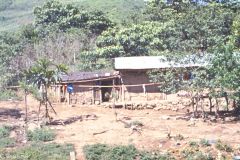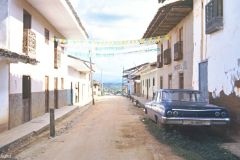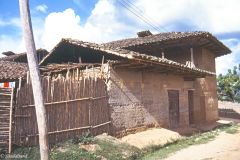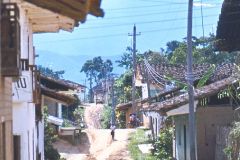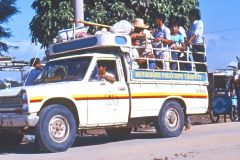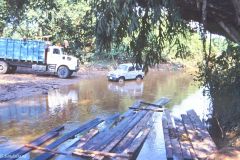This is the story of our travels in the Peruvian Amazon region and its difficult connections. We had stayed the night in Leticia, Colombia, the twin town of Tabatinga in Brazil and were set for an onward flight into the Peruvian Amazon and the town of Iquitos. Our journey out of the Amazon and into the Andes had begun.
This article is part of a travelogue from of a five month journey in 1987-1988 to several countries in South America: Brazil, Peru, Ecuador, Bolivia, Chile.
(Here is an introduction to our visit to Peru at the time of publishing (2013): We entered Peru from Brazil. We stayed a few weeks in the Amazon and the Andes before going north for a month in Ecuador. Upon returning to Peru we went straight to Lima and from there to Cuzco in the south. The text is a transcript of my original travel diary.)
Saturday 24.10.1987, Leticia – Tabatinga – Iquitos
Cruzeiro Airlines was a little delayed from Manaus and we did not get breakfast, only juice. In other respects it was an alright flight from Tabatinga in Brazil to Iquitos. It took us only 45 minutes. The formalities on both airports were alright and quite fast. We received Brazil stamps in our passports (we had not in Rio) and a three months visitor’s permit to Peru.

Entry and exit stamps in my passport from the first stay in Peru
At the airport we (the Swiss guy and the two of us) met a jungle guide. More correctly he was a freelancing tour pusher. He gave us a map, exchanged money for taxi and provided us with some info of Iquitos and jungle trips. The first parts were most important to us. Jaime was good at English and we followed his advice and took a taxi (90 intis) to this hotel.
- Hostal Pascano. Pevas no. 184. We’re paying 252 (6.3 USD) for two beds and a bathroom, no breakfast. Nice patio, a bit thin walls between the rooms but nice and clean. Breakfast is an additional 40 intis (1 USD) a person. Possible map.
(A currency note: We received 40 intis for a dollar US during our first stay in Peru. In Southern Peru, after returning from Ecuador one month later the rate was 80-85 to a dollar. I am here including the prices in intis as well as a dollar conversion at the going rate.)
Iquitos has an thought-provoking slum area named Belén where houses are built on poles. They are in the rainy season only reachable by canoe. It was interesting and its inhabitants were nice but we were struck by the poverty. We just had to take pictures.
We also visited a large market covering a number of city blocks. It was fascinating too.
Sunday 25.10.1987, Iquitos
We relaxed most of the day in the hostel with our diaries. When we tired of this, we had a late lunch on Plaza de 28 Julio, a square with several Chinese restaurants (chifas). There was one other foreign guest in the restaurant.
Later, as we had sat down on a bench in the park, he came over to us and asked in our own language and dialect if we were the ones from Stavanger, Norway. “– Eg hørre dåkker e’ fra Stavanger“.
Touché! The word of us was apparently around town and this guy was also from Stavanger. Weird. It turned out that he had been travelling in Latin America (Central and South) for two years and had been working here in Iquitos for 8 months selling jungle tours for an agency.
We talked a good deal about Peru, personal safety and travelling. He is the type of guy to be away for very long periods: Long, thin and lazy type of guy, and pleasant.
Monday 26.10.1987, Iquitos
We dropped by the Varig Airlines office and learned that we could use the flight ticket from Iquitos to Tabatinga as it was, on all IATA members. (As described previously we were obliged to buy a return ticket from Brazil to Peru but had in Manaus been informed that we could save that return to later.)
The man from home we met yesterday advised us that the best way of going to Ecuador was to travel to Yurimaguas and continue across the wild and beautiful mountains from there. Our thought was rather to fly to Pucallpa further south. That would have been a shortcut and we would possibly be able to take a river boat. I was beginning to renew my hopes of a boat ride on the Amazon when he mentioned that a boat trip from here would merely take 3-4 days.
This morning we went down to the port but there were no boats going to Yurimaguas. Therefore we continued to the Aero Peru office, but they only had a flight next Sunday (640 intis, students 480 (16/12 USD). Faucett Airlines on the other hand had a flight to Tarapoto not far from Yurimaguas and on the road across the Andes. The plane was scheduled for tomorrow already so we booked and paid 680 intis (17 USD) each.
This afternoon I bought three more rolls of film, for 175 each (4.5 USD). That was a good price and welcome replenishment. I had shot four rolls in Brazil, more than I had expected and about a fourth of what I had brought along.
Bo has become a whole lot better now, but still has the runs after meals. I had some stomach trouble after breakfast and took two pills. Now in the evening I have got rid of most of my regular belly pains.
A man on the street offered a bathroom weight for 2 intis. Bo hit the weight and refused me to look. That was altogether unnecessary as she had lost 2.5 kilos and was very happy about it. This confirmed by previous observations.
Tuesday 27.10.1987, Iquitos
We took a motocarro (similar to the tuk-tuk of Thailand) to the airport for 70 intis (less than two dollars). We hadn’t had any lunch so we ordered each our hamburger with a side-dish. I’ve rarely seen such slow and sour service. When Bo went to cancel the order they finally managed to come up with a not very good meal.
Down in the departure hall we were then informed that our plane to Tarapoto had been cancelled. It was apparently going to Cuzco instead! We were told that we would be able to fly with Aero Perutomorrow. At their office back in Iquitos this was confirmed and we settled for yet a day in Iquitos. There is not exactly much to see around here.
Wednesday 28.10.1987, Tarapoto
We finally got off. There was a mess at the Iquitos airport. After being kept waiting for ages we were let onto the aircraft just to be rejected and commanded back to the terminal. They were not ready for us. The 727 of Aero Peru did not hold the same standard as Cruzeiro’s. The flight was fast however, only three quarters of an hour or so.
We took a taxi (50 intis, 1 USD) into town and were let off at
- Hostal Juan Alfonso. Jr. Pedro de Urzúa. 145 intis (3.6 USD) for a twin bed room with private bath. Not a very good place, but fair enough. No breakfast. Nice staff but they managed to lose our key on one occasion and had great difficulties in finding the duplicate. Possible map.
We took a walk in town and had a look at daily life. Tarapoto is not the most picturesque small town I’ve been to, but some of the streets and shops and so on were interesting. There are no major sights here so we made an attempt to get an impression of the living conditions in a middle sized Peruvian town.
Beneath our hotel there is a nice little café. In the evening we sat down for cup of tea. TV news was on, with commercials. Bo spoke some Spanish and got in contact with the locals. They were nice and let us read their newspapers. We enjoyed that, starving as we were for news from the world scene.
This afternoon we tried to find transport onwards to Moyobamba but did not get any satisfactory answers.
Thursday 29.10.1987, Tarapoto – Lamas
This was a very interesting day, rich on content. We took a collectivo for half an hour to Lamas, a little “unspoilt Indian community” according to our guidebook.
Lamas was a little village with a history back to 1520 when a Spanish Conquistador was killing Indians in the area. Today it is divided into two districts with the indigenous population in one part and the mestizos in the other, up the hillside.
The road from Tarapoto was fascinating. We first drove through a wide, green valley and then uphill on basic roads through dense and lush vegetation.
The mestizo part of Lamas was pleasant with small, old houses and the ubiquitous Plaza de Armas in the middle. The adobe cabins and longhouses of the Indians were of a different standard. We went down there in the company of a bald Spanish-speaking tiny 13 year-old. We were let into a house to take pictures. Basic.
The boy Ramón was smart and knowledgeable. He managed to get us into the town museum, otherwise closed. It was a very interesting museum on the history of the town with figures and objects telling the story of the life and habits of the Indian population.
We bought Ramón lunch before we returned to Tarapoto. He did seem used to knife and fork, but had a clear ambition of becoming a doctor.
Our guidebook warned us against a restaurant, Las Tarazas, for offering lousy service. The service we received was in contrast unusually good.
Friday 30.10.1987, Tarapoto – Moyobamba – Rioja
Getting to Moyobamba
There are apparently two buses a week (90 intis, 2 USD) to Moyobamba, on Wednesdays and Saturdays. We did not bother wait until tomorrow so we chose a collectivo/camionete. They are departing every so often. This means of transportation is a pick-up car costing 150 for a seat inside and 100 for the back. We chose to spend the extra dollar for the sake of comfort and did not regret.
The road standard varied a lot. The mid third of the stretch had no asphalt concrete surface and it was a very bumpy ride particularly for those on the pick-up bed. The trip took a little more than two hours. The scenery was great with jungle and pleasant villages.
In Moyobamba we found Hostal Cobos right next to where the pick-up stopped. They had no rooms with a double bed available this early in the morning so we just left our backpacks in the reception and agreed to return after noon.
We went sightseeing in town and had an early lunch. I bought a soup made from milk, bread, meat and spaghetti. It was not particularly good. Bo had a fish that was partly raw.
Continuing on to Rioja
Moyobamba was full of police and the streets were like a board of chess. We found out that we had seen what was to be seen so we found a car going to Rioja, picked up our bags and left. The trip to Rioja cost us 30 intis (a dollar) and took 30 minutes.
Right by the pick-up stop we found our cheapest hotel in South America so far.
- Hostal San Martin. It cost us 115 intis (2.9 USD) for a double and with bath in the hall. There were cockroaches, dirty walls and a water closet with no flushing water. The linen looked clean.
Rioja is much smaller than Tarapoto and Moyobamba and with poorer buildings. There were a good number of adobe houses in outskirts and only a few streets had asphalt or concrete surface.
We did not figure on staying here for long, but then we coincidentally met Humberto on the plaza. He was a teacher in the town school and spoke fairly good English. We talked with him for some time and were later introduced to two of his friends, Wilfredo and Rosa Maria, a couple.
Getting to know a few locals
She was actually a private teacher in English, but quite incomprehensible to us. Her English was very weak. Wilfredo was substantially better, but he and Humberto clearly speak the language better than they understand it – which is close to zero.
We had a look inside a small and poor little room where Humberto was living. He’s paying 600 intis (15 USD) a month. Humberto showed us many interesting slides from Peru, many of them old tourist photos.
Humberto also took us to the public library where our presence caused a disturbance among the readers. We met the cultural secretary and the librarian and learned there would be a concert with folk music the following day. We were also presented a gift, an ashtray made of shells – large and nice – picked in a lake somewhere in this district.
Humberto is a part-time politician for the ruling government party and has a post as a photographer for a local magazine, la Selva. It’s being published monthly in a circulation of 3-4000 copies.
In the evening we went to a local radio station where Humberto had yet a spare time job. The station boss, Jorge, was an alert and charming guy (according to Bo) and wanted an interview with us.
So, we were then forced into a not too professional studio. On live broadcast we were encouraged to give a political, social and economic introduction to Norway. Well, we managed to talk some at least, while South American rhythms from the record player were creating the background and interval music. This was our first time on air and it was quite exciting.
There has been growing up a number of local radio stations all across Peru in later years, following a government liberalisation policy.
Saturday 31.10.1987, Rioja – Moyobamba
A day trip back to Moyobamba
We had yesterday been told that there were some hot springs, Baños Thermales, near Moyobambo. They were recommended and it even turned out that Wilfredo and his wife were going to Moyobamba. He was teaching English to a private school class. We thought his wife would be joining us but she had apparently lost her confidence.
We left Rioja in the morning after Humberto and his friends arrived according to good Peruvian tradition, half an hour late.
Upon arriving in Moyobamba it turned out that the springs was difficult to reach. We ended up taking a taxi (80 intis, 2 USD) uphill. Down in a little pond (well) the water was quite low on sulphur and kept a heat of 40 degrees Celsius. It was a pleasant bath tub temperature. We rounded it all off with a good shower and a swimming pool right next to the well.
We walked back down to Moyobamba. The 4-5 kilometres took us an hour.
An evening concert and more in Rioja
The concert we had been told should be in the afternoon but it turned out to be in the evening. Therefore we joined Humberto to a hat-maker where Bo bought herself a sunhat. She looked lovely in it. After this he insisted on showing us the airport, small and new.
The evening concert did of course not start at the announced time, and it was altogether disappointing. It proved to be one large commercial for a local bank using the opportunity to get new customers by staging a money and moped lottery for those who had a bank account.
The entertainment took ages and consisted in staging a few local artist amateurs who dared to enter the stage, young and old. It was rather boring. A teenager topped it all. He took up a centre stage position with sunglasses and started to dance rock with a cassette player sounding the music. It was a total failure and downright silly. One should think it was China.
Chinese-like was also the curiosity people showed us as we walked around on the plaza. This is apparently the big pastime here and especially Bo created a big fuss and gathering of crowds.
There are so-called “pink houses” all over Peru. The prostitutes pay, we were told, tax after having been registered with the authorities. Women ought to be virgins when they marry, but male virginity is less important. I was laughed at when I commented on this difference. Hookers take 100 intis (2.5 USD) for a short stand.
Sunday 01.11.1987, Rioja
Terrorism in Peru
The other sights in the area are a waterfall which did not interest us, a village called Palestina which Humberto and friends talked about going to or not. Last night we had agreed to join Humberto on a Sunday visit to a friend in a village.
When he finally arrived he brought with him the editor of the Selva magazine. They told us that a journalist colleague had been arrested and they were having a meeting about this. Consequently our trip was cancelled. We could understand that. We agreed to meet him at three in the afternoon in a restaurant by the river.
The editor spoke Spanish only but with Humberto as interpreter we had an interesting conversation on politics and the condition of journalism in the country. Apparently the only taboo is the terrorists (Sendero Luminoso and another group). They may publish pure news but no comments on this subject.
César the editor stated that Peru would not become another El Salvador or Nicaragua. The terrorists (liberators?) were way too unpopular among the common man, not least because they demanded supplies from people in the villages and because Sendero also attacks ordinary people and not only leading politicians, police and the military.
They told us of a village occupation where a police officer had been shot. This had happened not far from Rioja only two weeks ago. (Previously Wilfredo had informed us that the affair had taken place a week ago and Humberto had said a month.) The rebels operate in large groups of a couple of hundred men, with some being villagers forced to join them, attacking villages without police protection.
On this occasion they pulled out after a few hours and before the military turned up in large numbers. Today 400 special commandos will be arriving in the region for a show of force.
An invitation to the local radio station
We had dinner and went down to the river at three to meet the others. We waited for an hour and half with no one turning up. Bo suggested that the deal was to meet them at our hotel so we returned and met the group there. Humberto (or me, unlikely) had misunderstood us once again. (He speaks good English but it doesn’t seem like he understands much of what we say.)
Jorge – the radio man – was there too, and a disgusting drunkard with sunglasses making a go at my girlfriend. He is apparently a leading figure in the town hall and had invited César for a beer in the hope of convincing him into writing nice things.
In the end it became quite tense so the five of us withdrew to the riverside restaurant. The others, César in particular, wanted us to become foreign correspondents for La Selva and suggested even to include our names in the editorial column.
How we became foreign correspondents
We agreed to sending him some stuff every now and then about Norway and even to write an article this very evening for the next issue in November. They meant this would create a higher awareness of the magazine, an increased market status and more readers.
We thought this was an honour and let our pictures be taken. Newspapers in this country, like in Brazil, have nice bikini dressed girls on their front page. They consequently asked if Bo would pose for them. Well, she has her principles and the end of the story was that she posed fully dressed for a photograph without me on her side. She did wear a sun top and had a hip posture.
In the evening there was a bingo and entertainment. It was rather boring and it started to rain. Luckily we were under roof at our hotel, we had moved there yesterday.
- Hostal Ronald. 220 intis (5.5 USD) for a double room with bath, towels and toilet paper. Clean and nice. A good restaurant on the top floor.
During our stay especially Bo has reacted on the state of the young shoe shiners (5 intis). They are often orphans and have difficult conditions to grow up in as they have to make do on their own.
Read more
The next chapter: The next week we continued across the Andes in northern Peru and prepared to move on up north to Quito, Ecuador. I also wrote a letter home.
Read the introduction to this journey
View a full screen map of the journey

